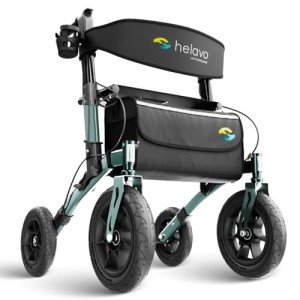The Comprehensive Guide to Padded Seat Walkers: Comfort and Mobility Combined
Mobility difficulties belong of life for lots of people, whether due to age, injury, or different health conditions. As a solution, the padded seat walker has emerged as a popular assistive gadget that not only help in mobility but likewise uses a resting option. This guide will check out the features and advantages of padded seat walkers, some factors to consider for selecting one, and a lot more.
What is a Padded Seat Walker?
A padded seat walker, also called a rolling walker or rollator, is a wheeled mobility aid geared up with a padded seat for resting. Non-Slip Rollator Walker have four wheels, handlebars, and a seat that enables users to navigate their surroundings securely while providing a spot to sit and recover when needed. The walker is especially useful for individuals who find themselves fatigued throughout extended walking or those who need additional support and stability.
Key Features of Padded Seat Walkers
Here is a detailed list of key features to consider when selecting a padded seat walker:
| Feature | Description |
|---|---|
| Padded Seat | Offers comfort during rest, frequently with back support to relieve sitting. |
| Wheels | Usually four wheels for stability and ease of motion, typically with locking mechanisms. |
| Manages | Ergonomic and adjustable manages that accommodate different user heights. |
| Brakes | Easy-to-use brake systems that improve safety and control while walking or resting. |
| Storage Options | Frequently includes a basket or pouch to carry individual products securely. |
| Lightweight Frame | Created for ease of transport and handling, normally made from aluminum or steel. |
| Mobility | Some designs fold for easy storage and transport, ideal for travel. |
Advantages of Using a Padded Seat Walker
A padded seat walker can significantly improve the quality of life for users. Here are several advantages:
- Safety and Stability: A padded seat walker provides additional support, minimizing the threat of falls and injuries.
- Convenience: With a built-in seat, users can take breaks as required without searching for a location to rest.
- Improved Mobility: Walkers encourage motion and exploration, promoting self-reliance and motivating a much healthier way of life.
- Comfort: Padded seats and ergonomic manages are created to offer comfort throughout use, lessening pressure on the body.
- Easy to use: These walkers are frequently easy to use with minimal training, making them accessible for a broad variety of users.
Choosing the Right Padded Seat Walker
When selecting a padded seat walker, think about the following elements:
1. Size and Weight Capacity
It's vital to pick a walker that accommodates the user's size and weight. Check the weight limits specified by the producer and make sure the walker supplies adequate stability.
2. Adjustability
Try to find designs with adjustable handles to personalize the walker height for comfort and safety. This feature is particularly essential for users of varying heights.
3. Seat Height and Comfort
Ensure that the seat height is appropriate for the user. A comfortable padded seat with back support will improve the resting experience.
4. Wheel Type
Wheels come in various sizes and styles. Bigger wheels might perform much better on unequal surfaces, while smaller wheels are easier to maneuver inside.
5. Additional Features
Think about additionals such as integrated storage, brake systems, and safety features. Advanced models might include accessories like cup holders or back-rests.
How to Use a Padded Seat Walker
For optimum benefit and security, users must know proper strategies:
- Adjust the Walker: Set the walker to the proper height, guaranteeing that the user can comfortably grip the handlebars while standing directly.
- Test Mobility: Before advance, users should make sure the brakes are disengaged and the walker is stable.
- Maintain Posture: Engage core muscles and preserve a straight posture while walking. The user must keep their weight centered over the walker.
- Take Breaks: If feeling tired out, the user can stop, engage the brakes, and rest on the padded seat to rest.
- Shop Items Securely: Place personal belongings in the walker's storage compartment to prevent carrying extra weight.
Regularly Asked Questions (FAQ)
Q1: Who can gain from utilizing a padded seat walker?
A1: Padded seat walkers are advantageous for elderly individuals, those recuperating from surgical treatment, or anyone with mobility problems who requires support while walking.
Q2: How do I figure out which size walker to get?
A2: Consider the user's height and weight, and inspect the walker specifications for weight limitations and size recommendations.
Q3: What is the typical lifespan of a padded seat walker?
A3: With correct care and upkeep, padded seat walkers can last a number of years, generally between 5 to 10 years.
Q4: Can I use a padded seat walker outdoors?
A4: Yes, lots of padded seat walkers appropriate for outdoor use, supplied they have actually sufficient wheels created for different surface areas.
Q5: How do I maintain a padded seat walker?
A5: Regularly examine the brakes and wheels for wear, clean the frame, and ensure that all parts are working properly for safety.
Last Thoughts
Padded seat walkers represent an essential resource in promoting self-reliance and mobility for those dealing with physical obstacles. By using convenience, stability, and safety, they help improve the lifestyle for users. If you or a liked one are considering a padded seat walker, this detailed guide needs to assist in making an informed option. Accepting mobility help can cause a fulfilling and active lifestyle, proving that ease of movement is obtainable at any age or condition.

